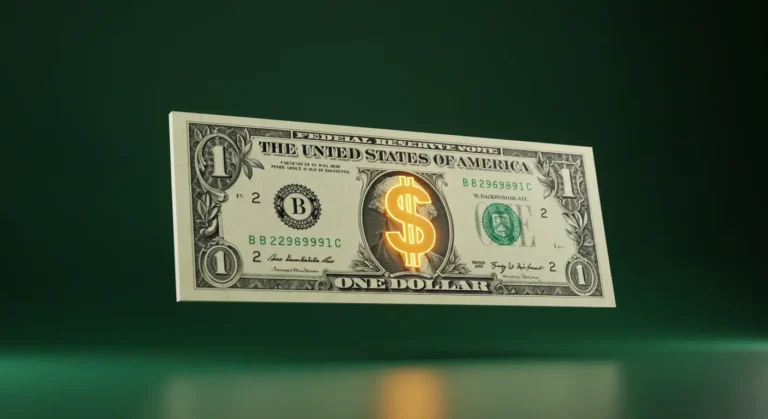What is the $1 rule? It’s a simple yet profound concept that can transform your financial habits and attitudes toward money. Picture this: you’re at a café, sipping your favorite brew, and you come across a piece of advice that claims that anything you want to buy for more than a dollar should be carefully considered. This advice is part of a broader ideology that emphasizes mindfulness in spending. Its relevance extends beyond mere frugality, touching on the psychological and emotional aspects of our financial decisions.
At its core, the $1 rule encourages us to evaluate each purchase and its implications on our financial health. It’s about more than just saving money; it’s about cultivating a mindset where every dollar spent reflects our values and priorities. This rule speaks to the modern complexities of consumerism, where impulse purchases often derail our financial goals. Understanding and implementing the $1 rule can help you reclaim control over your finances and guide you toward a more intentional and fulfilling life.
Imagine Emma, a busy professional who once never thought twice about grabbing that $5 latte every morning. After learning about the $1 rule, she began to question her daily choices. Emma soon discovered that tracking her spending habits not only allowed her to save money but also gave her deeper insights into her desires and priorities. The $1 rule isn’t just about the money; it’s about understanding ourselves and making conscious choices that foster joy and satisfaction.
In a world where every dollar counts, especially in uncertain economic times, the $1 rule is your ally in cultivating smarter financial habits. It empowers you to make choices that align with your long-term goals and encourages financial growth while minimizing regret. So, let’s delve deeper and explore the many facets of the $1 rule and how it can shape your financial future.
The Psychological Impact of the $1 Rule
The $1 rule isn’t just about counting coins; it’s about understanding the psychological impact of our spending habits. When we think of every purchase in terms of its significance, we become more attuned to our desires and motivations.
Mindfulness in Spending
The first step in applying the $1 rule is mindfulness. Before making any purchase over a dollar, pause and ask yourself a few questions:
- Do I really need this?
- Will this purchase bring me lasting happiness?
- What could I do with this money instead?
By reflecting on these questions, you shift from mindless consumerism to deliberate spending, leading to more fulfilling financial decisions.
Reducing Impulse Purchases
Impulse purchases are often fueled by emotions, making them hard to resist. The $1 rule serves as a mental barrier against these spontaneous choices. For instance, if you’re at the store preparing to buy a trendy gadget, remember to pause. By contemplating whether it’s worth the investment, you might realize that a simple $1 app could achieve the same result.
Practical Applications of the $1 Rule
Now that we’ve explored the psychological underpinnings, let’s look at practical applications of the $1 rule in our daily lives. It’s one thing to know the rule; applying it effectively can yield significant benefits.
Setting a Budget
The $1 rule can seamlessly integrate into monthly budgeting. By ensuring that every discretionary expenditure is evaluated against your financial goals, you create a sustainable budget. For example, if you allocate a specific portion of your income for entertainment, knowing that each dollar needs careful consideration can help you enjoy activities without overspending.
Tracking Your Expenses
Implement a simple tracking system using apps or spreadsheets. By categorizing your expenses, you can gauge which areas require more scrutiny. For instance, tracking coffee shop visits might reveal that you spend more than you thought—leading you to make a conscious decision about a less frequent, but enjoyable, visit.
The $1 Rule and Financial Freedom
The ultimate goal of the $1 rule is to lead you toward financial freedom. It’s not just about saving pennies—it’s about enabling your future self to thrive.
Investing and Saving
By applying the $1 rule to your investment strategy, you begin to see the power of compounding. For every dollar saved or wisely invested, you’re making a choice that can pay off significantly in the long term. Imagine putting away just $1 a day into a savings account or investment vehicle—by the end of the year, you’ve set aside $365, which can grow exponentially with interest or dividends.
Reevaluating Your Goals
As you carry out the $1 rule, don’t forget to reevaluate your financial goals regularly. Do your spending habits align with what you truly value? If not, it’s time to readjust either your goals or your expenditures. Financial freedom comes from a blend of mindful expenditure and disciplined saving, guided by the principles of the $1 rule.
Challenges and Misconceptions
The “All or Nothing” Mentality
One common misconception is that strict adherence is necessary; any deviation can lead to failure. However, the $1 rule is flexible. If you spend more than a dollar on a purchase, it doesn’t mean you’ve failed. Instead, it’s an opportunity to learn. Reflect on why this purchase mattered and how you might adjust in the future.
Overemphasis on Penny-Pinching
Another pitfall is viewing the $1 rule as purely a means of being frugal. The aim isn’t to deprive yourself of enjoyment. It’s about intentionally investing your dollars in things that truly matter to you, like experiences, relationships, or long-term goals—rather than allowing money to slip through your fingers on fleeting whims.
Communicating the $1 Rule
Finally, let’s touch on how you can communicate and share the wisdom of the $1 rule with friends and family. Financial literacy is a collective journey, and your insights can help others navigate their financial paths.
Engaging Conversations
When discussing the $1 rule, opt for engaging conversations rather than lectures. Share your personal experiences, like Emma’s transformation, and encourage them to apply it to their lives. Ask open-ended questions, inviting them to reflect on their spending and how it aligns with their desires.
Building a Supportive Community
Consider forming a financial accountability group. Sharing your successes and challenges related to the $1 rule can foster a sense of community. You can celebrate each other’s victories, discuss hurdles, and share strategies to overcome them. This camaraderie can make the financial journey less daunting and more enjoyable.

Useful links
Conclusion
To wrap things up, the $1 rule serves as a powerful guide for our spending habits. It encourages us to evaluate whether a purchase is truly worth it by challenging us to ask, “Is this item worth one hour of my life?” By shifting our perspective like this, we gain a clearer understanding of what truly matters to us. It’s not just about the dollar amount; it’s about the value of our time and how we want to spend it.
You might find that what you once deemed essential is less important than experiences that enrich your life. It’s liberating and can lead us to make choices that align more closely with our values and dreams. Imagine an impulse buy suddenly feeling more substantial and meaningful when you realize it might cost you a precious hour of your time.
So, the next time you’re about to swipe your card, take a moment. Think about how that purchase measures against your personal goals and the life you want to lead. Trust me, it can lead to more intentional spending and a more fulfilling financial life. After all, every dollar spent is a piece of our time, and we all want our time to be spent wisely.
Frequently Asked Questions
What is the essence of the $1 rule?
The essence of the $1 rule is to measure a potential purchase against the time you spent earning that money. Essentially, for every dollar you consider spending, ask yourself if it’s worth the time you invested to earn it. This perspective helps clarify value, steering you toward intentional spending. Instead of blindly buying, you assess whether the item contributes meaningfully to your life, thus promoting wiser financial habits and encouraging you to invest in what truly matters.
How can I practically apply the $1 rule in daily life?
To apply the $1 rule practically, start by calculating your hourly wage. From there, for every dollar item you want, translate it to hours worked. For instance, if you earn $15 an hour, a $10 purchase costs you forty minutes of work. Before finalizing your purchase, pause and evaluate: is what you’re buying worth that time? This deliberate decision-making process ensures that you focus on purchases that align with your values and priorities, leading to more satisfying spending.
Is the $1 rule applicable for larger purchases as well?
Absolutely! The $1 rule works for larger purchases too. When considering something significant like a vacation or a new smartphone, reflect on the time needed to earn that amount. For example, if a trip costs $1,000 and your hourly wage is $20, that equates to 50 hours of work. This helps contextualize the expense, making you weigh whether the experience or benefit justifies the time you’ll need to work to afford it. This approach ensures that bigger decisions are made thoughtfully and purposefully.
What are the psychological benefits of using the $1 rule?
Using the $1 rule encourages mindfulness, helping you develop a more conscious relationship with money. This shift fosters greater appreciation for how you spend both time and money, often leading to reduced impulse purchases. Psychologically, this creates a sense of control and accomplishment as you align financial decisions with personal values, promoting not just financial well-being but also emotional satisfaction. As you become more aware of your purchasing habits, you might find a boost in confidence and a decrease in financial guilt.
Can the $1 rule help me save money in the long run?
Yes! By adopting the $1 rule, you are likely to make more intentional choices about your spending, which can significantly enhance your ability to save money. When you carefully evaluate each purchase by considering how much time it represents, you may opt to forgo unnecessary items, redirecting those funds to savings or investments instead. Over time, these small yet impactful changes can accumulate, leading to substantial savings and a stronger financial future.
Are there any potential downsides to the $1 rule?
While the $1 rule can be beneficial, it may also lead to overthinking or excessive analysis paralysis, especially when making decisions about smaller items. If you find yourself second-guessing every purchase, it could create unnecessary stress and frustration. It’s important to strike a balance—use the rule as a guiding principle rather than a strict formula. Remember, the ultimate goal is to enhance your financial wellness without losing enjoyment in life’s little pleasures.
How can I stay motivated to follow the $1 rule?
Staying motivated involves reminding yourself why you embraced the $1 rule in the first place. Set clear financial goals—whether saving for a dream vacation or achieving debt freedom—and celebrate small wins along the way. Keeping a journal to track your progress can also help maintain your commitment. Share your journey with friends or family, fostering a support system that encourages mindful spending. By aligning the $1 rule with personal goals, you reinforce its value, which can keep your motivation high.


